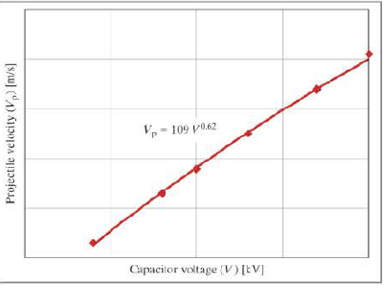
- 14. The data shown in the following graph was collected during testing of an electromagnetic mass driver. The energy to energize the electromagnets was obtained from a bank of capacitors. The capacitor bank was charged to various voltages, and for each voltage, the exit velocity of the projectile was measured when the mass driver was activated.

-
Note
Due to several complicated nonlinear losses in the system that are far beyond the
scope of this course, this is a case of a power model in which the exponent does not come out to be an integer or simple fraction, so rounding to two significant figures is appropriate. In fact, this model is only a first approximation-a really accurate model would be considerably more complicated.
-
- a. What would the velocity be if the capacitors were charged to 100,000 volts?
- b. What voltage would be necessary to accelerate the projectile to 1000 meters per second?
- c. Assume that the total capacitance is 5 farads. If the capacitors are initially charged to 10,000 volts and are discharged to 2000 volts during the launch of a projectile, what is the mass of the projectile if the overall conversion of energy stored in the capacitors to kinetic energy in the projectile has an efficiency of 20%? Recall that the energy stored in a capacitor is given by E = 0.5 CV2, where C is capacitance in farads and V is voltage in volts.
Trending nowThis is a popular solution!
Learn your wayIncludes step-by-step video

Chapter 12 Solutions
Thinking Like an Engineer: An Active Learning Approach (3rd Edition)
Additional Engineering Textbook Solutions
Starting Out With Visual Basic (8th Edition)
Java How to Program, Early Objects (11th Edition) (Deitel: How to Program)
Electric Circuits. (11th Edition)
Degarmo's Materials And Processes In Manufacturing
Fluid Mechanics: Fundamentals and Applications
Mechanics of Materials (10th Edition)
- Hot water is flowing at an average velocity of 5.82 ft/s through a cast iron pipe (k=30 Btu/h-ft-°F) whose inner and outer diameters are 1.0 in and 1.2 in, respectively. The pipe passes through a 50-ft-long section of a basement whose temperature is 60°F. The emissivity of the outer surface of the pipe is 0.5, and the walls of the basement are also at about 60°F. If the inlet temperature of the water is 150°F and the heat transfer coefficient on the inner surface of the pipe is 30 Btu/h-ft².°F, determine the temperature drop of water as it passes through the basement. Evaluate air properties at a film temperature of 105°C and 1 atm pressure. The properties of air at 1 atm and the film temperature of (Ts+ T∞)/2 = (150+60)/2 = 105°F are k=0.01541 Btu/h-ft-°F. v=0.1838 × 10-3 ft2/s, Pr = 0.7253, and ẞ = 0.00177R-1arrow_forwardhand-written solutions only, please. correct answers upvoted!arrow_forwardhand-written solutions only, please. correct answers upvoted!arrow_forward
- ! Required information Consider a flat-plate solar collector placed horizontally on the flat roof of a house. The collector is 1.3 m wide and 2.8 m long, and the average temperature of the exposed surface of the collector is 42°C. The properties of air at 1 atm and the film temperature are k=0.02551 W/m-°C, v = 1.562 × 10-5 m²/s, Pr = 0.7286, and ẞ= 0.003356 K-1 Determine the rate of heat loss from the collector by natural convection during a calm day when the ambient air temperature is 8°C. The rate of heat loss from the collector by natural convection is W.arrow_forwardhand-written solutions only, please. correct answers upvoted!arrow_forwardhand-written solutions only, please. correct answers upvoted!arrow_forward
- Please find the torsional yield strength, the yield strength, the spring index, and the mean diameter.arrow_forward(read image) (Answer Given)arrow_forward6.76 A wind turbine is operating in a 12 m/s wind that has a den- sity of 1.2 kg/m³. The diameter of the turbine silhouette is 4 m. The constant-pressure (atmospheric) streamline has a diameter of 3 m upstream of the windmill and 4.5 m downstream. Assume that the velocity distributions are uniform and the air is incom- pressible. Determine the force on the wind turbine. m P = Patm 4 Vz 4m 4 m Fx. Problem 6.76arrow_forward
 Automotive Technology: A Systems Approach (MindTa...Mechanical EngineeringISBN:9781133612315Author:Jack Erjavec, Rob ThompsonPublisher:Cengage Learning
Automotive Technology: A Systems Approach (MindTa...Mechanical EngineeringISBN:9781133612315Author:Jack Erjavec, Rob ThompsonPublisher:Cengage Learning Refrigeration and Air Conditioning Technology (Mi...Mechanical EngineeringISBN:9781305578296Author:John Tomczyk, Eugene Silberstein, Bill Whitman, Bill JohnsonPublisher:Cengage Learning
Refrigeration and Air Conditioning Technology (Mi...Mechanical EngineeringISBN:9781305578296Author:John Tomczyk, Eugene Silberstein, Bill Whitman, Bill JohnsonPublisher:Cengage Learning

